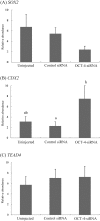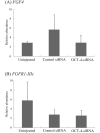OCT-4 expression is essential for the segregation of trophectoderm lineages in porcine preimplantation embryos
- PMID: 27210587
- PMCID: PMC5004796
- DOI: 10.1262/jrd.2016-040
OCT-4 expression is essential for the segregation of trophectoderm lineages in porcine preimplantation embryos
Abstract
Oct-4, a member of the POU family of transcription factors, is a key factor that regulates the segregation of the inner cell mass (ICM) and the trophectoderm (TE) during the transition from morula to blastocyst in mice. However, little is known about its role in porcine early embryogenesis. To determine the function of OCT-4 in the ICM and TE segregation of porcine embryos, we studied the developmental morphology of porcine embryos using RNA interference technology. Our experiments demonstrated that when 1-cell stage embryos were co-injected with the small interfering RNA (siRNA)for targeted knockdown of OCT-4 (OCT-4-siRNA) and tetramethylrhodamine isothiocyanate (TRITC)-dextran conjugate (Dx), they failed to form blastocysts. Therefore, in this study, we constructed chimeric embryos comprising blastomeres that either expressed OCT-4 normally or showed downregulated OCT-4 expression by co-injection of OCT-4-siRNA and Dx into one blastomere in 2- to 4-cell stage embryos. In control embryos, which were co-injected with control siRNA and Dx, Dx-positive cells contributed to the TE lineage in almost all the blastocysts examined. In contrast, Dx-positive cells derived from a blastomere co-injected with OCT-4-siRNA and Dx were degenerated in almost half the blastocysts. This was probably due to the inability of these cells to differentiate into the TE lineage. Real-time RT-PCR analysis revealed no difference in the levels of SOX2, TEAD4, FGF4 and FGFR1-IIIc, all of which are known to be regulated by OCT-4, between the OCT-4-siRNA-injected morulae and the control ones. However, the level of CDX2, a molecule specifically expressed in the TE lineage, was significantly higher in the former than in the latter. Our results indicate that continuous expression of OCT-4 in blastomeres is essential for TE formation of porcine embryos.
Figures




Similar articles
-
Roles of cell differentiation factors in preimplantation development of domestic animals.J Reprod Dev. 2021 Jun 21;67(3):161-165. doi: 10.1262/jrd.2021-031. Epub 2021 Apr 27. J Reprod Dev. 2021. PMID: 33907058 Free PMC article. Review.
-
Changes in the expression patterns of the genes involved in the segregation and function of inner cell mass and trophectoderm lineages during porcine preimplantation development.J Reprod Dev. 2013;59(2):151-8. doi: 10.1262/jrd.2012-122. Epub 2012 Dec 20. J Reprod Dev. 2013. PMID: 23257836 Free PMC article.
-
Sox2 is essential for formation of trophectoderm in the preimplantation embryo.PLoS One. 2010 Nov 12;5(11):e13952. doi: 10.1371/journal.pone.0013952. PLoS One. 2010. PMID: 21103067 Free PMC article.
-
The Necessity of OCT-4 and CDX2 for Early Development and Gene Expression Involved in Differentiation of Inner Cell Mass and Trophectoderm Lineages in Bovine Embryos.Cell Reprogram. 2016 Oct;18(5):309-318. doi: 10.1089/cell.2015.0081. Epub 2016 Aug 8. Cell Reprogram. 2016. PMID: 27500421
-
Mechanisms of trophectoderm fate specification in preimplantation mouse development.Dev Growth Differ. 2010 Apr;52(3):263-73. doi: 10.1111/j.1440-169X.2009.01158.x. Epub 2010 Jan 20. Dev Growth Differ. 2010. PMID: 20100249 Review.
Cited by
-
The necessity of TEAD4 for early development and gene expression involved in differentiation in porcine embryos.J Reprod Dev. 2019 Aug 9;65(4):361-368. doi: 10.1262/jrd.2018-120. Epub 2019 May 25. J Reprod Dev. 2019. PMID: 31130592 Free PMC article.
-
SOX2 plays a crucial role in cell proliferation and lineage segregation during porcine pre-implantation embryo development.Cell Prolif. 2021 Aug;54(8):e13097. doi: 10.1111/cpr.13097. Epub 2021 Jul 11. Cell Prolif. 2021. PMID: 34250657 Free PMC article.
-
Cell fate determination and Hippo signaling pathway in preimplantation mouse embryo.Cell Tissue Res. 2021 Dec;386(3):423-444. doi: 10.1007/s00441-021-03530-8. Epub 2021 Sep 29. Cell Tissue Res. 2021. PMID: 34586506 Review.
-
Copper Oxide Nanoparticles Impair Mouse Preimplantation Embryonic Development through Disruption of Mitophagy-Mediated Metabolism.ACS Nano. 2024 Nov 12;18(45):31244-31260. doi: 10.1021/acsnano.4c09734. Epub 2024 Nov 2. ACS Nano. 2024. PMID: 39487804 Free PMC article.
-
Roles of cell differentiation factors in preimplantation development of domestic animals.J Reprod Dev. 2021 Jun 21;67(3):161-165. doi: 10.1262/jrd.2021-031. Epub 2021 Apr 27. J Reprod Dev. 2021. PMID: 33907058 Free PMC article. Review.
References
-
- Yeom YI, Fuhrmann G, Ovitt CE, Brehm A, Ohbo K, Gross M, Hübner K, Schöler HR. Germline regulatory element of Oct-4 specific for the totipotent cycle of embryonal cells. Development 1996; 122: 881–894. - PubMed
-
- Nichols J, Zevnik B, Anastassiadis K, Niwa H, Klewe-Nebenius D, Chambers I, Schöler H, Smith A. Formation of pluripotent stem cells in the mammalian embryo depends on the POU transcription factor Oct4. Cell 1998; 95: 379–391. - PubMed
-
- Kirchhof N, Carnwath JW, Lemme E, Anastassiadis K, Schöler H, Niemann H. Expression pattern of Oct-4 in preimplantation embryos of different species. Biol Reprod 2000; 63: 1698–1705. - PubMed
-
- Takahashi K, Yamanaka S. Induction of pluripotent stem cells from mouse embryonic and adult fibroblast cultures by defined factors. Cell 2006; 126: 663–676. - PubMed
MeSH terms
Substances
LinkOut - more resources
Full Text Sources
Other Literature Sources
Molecular Biology Databases
Miscellaneous

